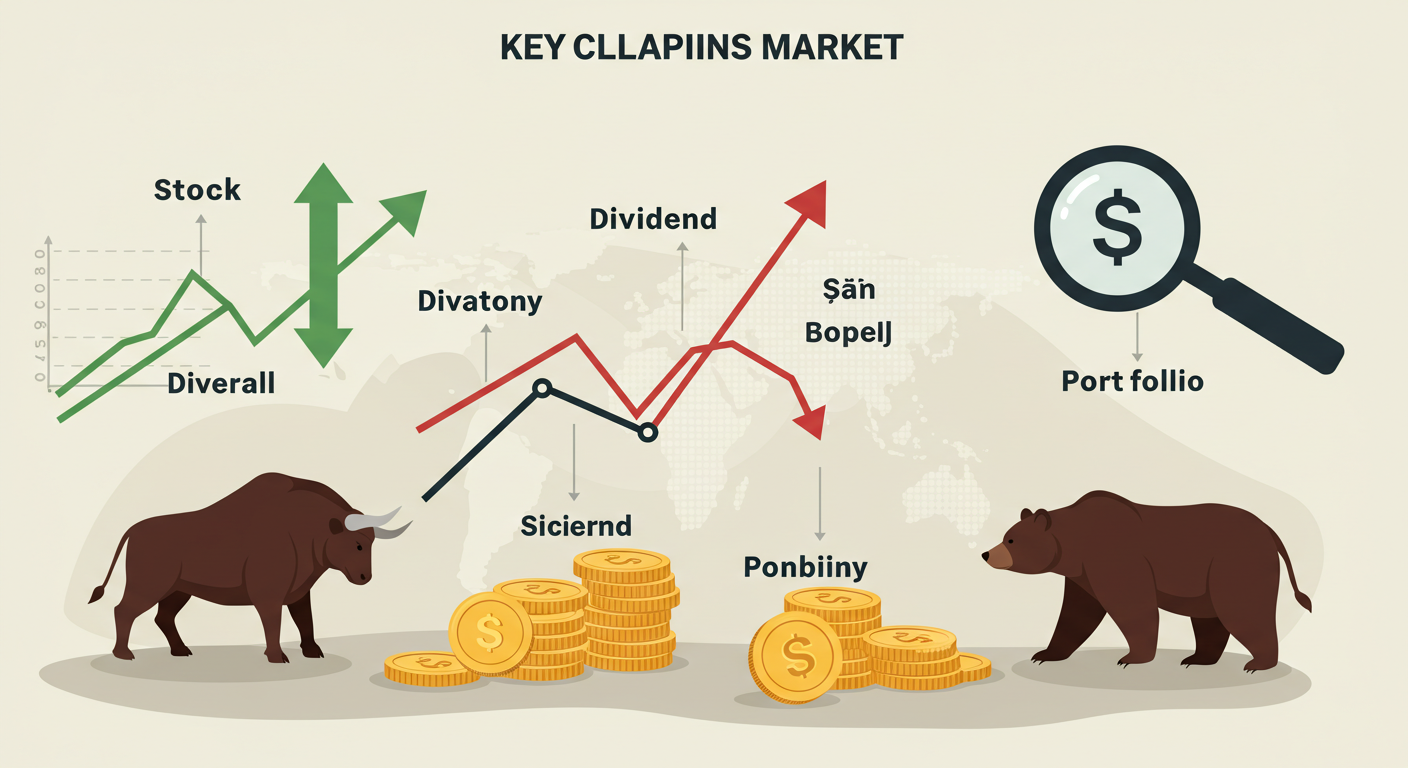The stock market can feel like a maze of confusing words and ideas, especially if you’re new to investing. Terms like “dividends,” “bull market,” or “P/E ratio” might sound intimidating, but they don’t have to be.
This article is your one-stop resource for learning stock market terminology. Whether you’re thinking about buying your first stock or just want to understand what financial news is talking about, this guide has you covered. Let’s get started with the basics and move on to more advanced terms, all explained in a way that’s easy to follow.
What Is the Stock Market?
The stock market is a place where people buy and sell pieces of companies, called stocks. When you buy a stock, you own a small part of that company. The stock market is like a big online marketplace where these transactions happen every day. It’s where businesses raise money to grow, and investors try to make money by buying and selling stocks.
Understanding the stock market starts with learning its language. Below, I’ll explain the most important terms you’ll come across, grouped into categories for clarity.
The Basics: Key Terms for Beginners
Let’s start with the foundational words you’ll hear all the time in the stock market. These are the building blocks of investing.
Stock
A stock is a share in a company. When you buy a stock, you become a part-owner of that company. For example, if you buy a stock in Apple, you own a tiny piece of Apple. Stocks are traded on stock exchanges, like the New York Stock Exchange (NYSE) or Nasdaq.
Share
A share is another word for a stock. It represents your ownership in a company. If a company has 100 shares and you own 1, you own 1% of that company.
Stock Exchange
A stock exchange is a marketplace where stocks are bought and sold. Think of it like an online store for stocks. The NYSE and Nasdaq are the biggest stock exchanges in the United States, but there are others around the world, like the London Stock Exchange or Tokyo Stock Exchange.
Broker
A broker is a person or company that helps you buy and sell stocks. They act as a middleman between you and the stock exchange. Today, many people use online brokers like Robinhood, E*TRADE, or Fidelity, which make trading easy and affordable.
Portfolio
Your portfolio is the collection of all the investments you own, like stocks, bonds, or other assets. Think of it as your investment “basket.” A good portfolio is diverse, meaning it has different types of investments to reduce risk.
Dividend
A dividend is money a company pays to its shareholders, usually every three months. It’s like a thank-you for owning their stock. Not all companies pay dividends, but those that do, like Coca-Cola or Johnson & Johnson, are popular with investors who want steady income.
Market Movements: Understanding Trends
The stock market is always moving, and certain terms describe how it’s behaving. These words help you understand whether stocks are going up, down, or staying steady.
Bull Market
A bull market happens when stock prices are rising, and people are optimistic about the future. It’s called “bull” because bulls charge forward, symbolizing growth. For example, after the 2008 financial crisis, the stock market entered a long bull market that lasted over a decade.
Bear Market
A bear market is the opposite of a bull market. It’s when stock prices are falling, and people are pessimistic. Bears swipe downward, which is why this term describes a declining market. A bear market is often defined as a drop of 20% or more from a market’s high point.
Volatility
Volatility describes how much stock prices move up and down. If prices change a lot in a short time, the market is “volatile.” Low volatility means prices are stable. For example, tech stocks like Tesla can be very volatile, while utility stocks are usually calmer.
Correction
A correction is when the stock market drops by 10% to 20% from its recent high. It’s like the market taking a breather after a big run-up. Corrections are normal and often temporary, but they can feel scary if you’re new to investing.
Buying and Selling: How Trading Works
Trading stocks involves specific terms that describe how you buy, sell, and make decisions. Here’s what you need to know.
Bid and Ask
The bid is the highest price someone is willing to pay for a stock, and the ask is the lowest price someone is willing to sell it for. The difference between the bid and ask is called the spread. For example, if the bid is $50 and the ask is $51, the spread is $1.
Market Order
A market order is when you tell your broker to buy or sell a stock at the current price. It’s the fastest way to trade, but you might not get the exact price you expect if the market is moving quickly.
Limit Order
A limit order lets you set a specific price at which you want to buy or sell a stock. For example, you might say, “Buy this stock only if it drops to $100.” It gives you more control but might not happen if the price doesn’t reach your limit.
Stop-Loss Order
A stop-loss order is a way to protect yourself from big losses. You set a price where your stock will automatically sell if it drops too low. For example, if you buy a stock at $100 and set a stop-loss at $90, your stock will sell if it falls to $90, limiting your loss.
Company and Stock Metrics: Measuring Value
To decide which stocks to buy, investors look at numbers that show how a company is doing. These metrics are like a company’s report card.
Market Capitalization
Market capitalization, or “market cap,” is the total value of a company’s stocks. It’s calculated by multiplying the stock price by the number of shares. For example, if a company has 1 million shares at $50 each, its market cap is $50 million. Companies are often grouped as:
- Large-cap: Over $10 billion (e.g., Apple, Microsoft).
- Mid-cap: $2 billion to $10 billion.
- Small-cap: Under $2 billion.
P/E Ratio
The price-to-earnings (P/E) ratio shows how much investors are paying for each dollar of a company’s earnings. It’s calculated by dividing the stock price by the earnings per share (EPS). A high P/E, like 30, means investors expect big growth. A low P/E, like 10, might mean the stock is undervalued.
Earnings Per Share (EPS)
EPS is how much profit a company makes per share of stock. It’s calculated by dividing the company’s total profit by the number of shares. For example, if a company earns $1 million and has 1 million shares, its EPS is $1. Higher EPS is usually better.
Dividend Yield
The dividend yield shows how much a company pays in dividends compared to its stock price. It’s a percentage, calculated by dividing the annual dividend by the stock price. For example, if a stock pays $2 per year in dividends and costs $50, the yield is 4%. This is important for income-focused investors.
Advanced Terms: Digging Deeper
Once you’re comfortable with the basics, these terms will help you understand more complex ideas in the stock market.
IPO (Initial Public Offering)
An IPO is when a company sells its stocks to the public for the first time. It’s how private companies, like Airbnb or Uber, become public companies. IPOs are exciting because they let everyday investors buy into new companies, but they can be risky.
Blue-Chip Stocks
Blue-chip stocks are shares in big, stable, well-known companies, like Walmart or Procter & Gamble. They’re called “blue-chip” because they’re reliable, like the highest-value chips in poker. These stocks are often safe bets for long-term investors.
Index
An index tracks the performance of a group of stocks. For example, the S&P 500 index includes 500 big U.S. companies, like Amazon and Coca-Cola. It’s like a snapshot of how the market is doing. Many investors buy index funds, which are investments that track an index.
ETF (Exchange-Traded Fund)
An ETF is a type of investment that holds a basket of stocks, bonds, or other assets. It trades like a stock on an exchange. ETFs are popular because they’re low-cost and diverse. For example, an S&P 500 ETF lets you invest in all 500 companies in that index with one purchase.
Margin
Margin is when you borrow money from your broker to buy stocks. It’s like using a loan to invest. Margin can increase your profits if stocks go up, but it’s risky—if stocks go down, you could lose more than you invested.
Risks and Strategies: Staying Smart
Investing isn’t just about picking stocks; it’s about managing risks and making smart choices. These terms will help you plan your strategy.
Diversification
Diversification means spreading your investments across different stocks, industries, or asset types (like stocks and bonds). It’s like not putting all your eggs in one basket. If one stock crashes, others might still do well, reducing your overall risk.
Dollar-Cost Averaging
Dollar-cost averaging is when you invest a fixed amount of money regularly, no matter what the market is doing. For example, you might buy $100 of a stock every month. This strategy helps you avoid buying too much when prices are high.
Fundamental Analysis
Fundamental analysis is when you study a company’s financial health to decide if its stock is a good buy. You look at things like earnings, revenue, and debt. It’s like checking a car’s engine before buying it.
Technical Analysis
Technical analysis is when you study stock price charts and patterns to predict future movements. Instead of looking at the company’s business, you focus on price trends and trading volume. It’s like forecasting the weather by watching clouds.
Common Mistakes to Avoid
As someone who’s written about finance for years, I’ve seen beginners make avoidable mistakes. Here are a few terms related to pitfalls and how to steer clear:
- Chasing Trends: Buying a stock just because it’s going up fast. This can lead to buying at a high price, only to see it crash later.
- Panic Selling: Selling stocks quickly during a market drop out of fear. This often locks in losses instead of waiting for a recovery.
- Overleveraging: Using too much margin (borrowed money) to invest. This can lead to big losses if the market turns against you.
Why Understanding These Terms Matters
Knowing stock market terminology empowers you to make informed decisions. Whether you’re reading financial news, talking to a broker, or choosing stocks, these terms are the language of investing. As Jose E. McKenna, I’ve used my experience to simplify these concepts so you can confidently navigate the stock market. My goal is to help you feel comfortable with investing, whether you’re aiming to grow wealth or just understand how the market works.
How to Use This Guide
This guide is designed to be your reference for stock market terms. Keep it handy when you’re:
- Watching financial news and hearing unfamiliar words.
- Talking to a financial advisor or broker.
- Researching stocks to build your portfolio.
- Learning about investing through books, podcasts, or online courses.
If you’re new, start with the basic terms and revisit the advanced ones as you gain confidence. If you’re experienced, use this as a refresher or share it with friends who are just starting out.
Final Thoughts
The stock market doesn’t have to be scary or confusing. With the right knowledge, you can approach it with confidence.
Investing is a journey, and understanding the language is the first step. Save this guide, refer to it often, and feel free to explore the stock market with curiosity and caution. If you have more questions or want to dive deeper into a specific term, let me know—I’m here to help!
Also Read: NASDAQ: MSTR – Why MicroStrategy’s Bitcoin Plan Is Soaring and What Could Go Wrong
Disclaimer: This article is only for learning and information. It is not financial advice. I am not telling you to buy or sell any stocks. The content here is not promotional, not an affiliate article, and not connected with any company or broker. Please do your own research or talk to a licensed financial advisor before making any investment decisions.





Leave a Reply